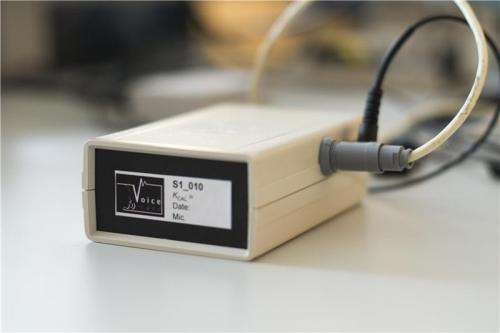A low-cost voice monitoring device to combat functional dysphonia

Functional dysphonia is the nightmare of professional singers and even more so of amateur actors, but also of teachers and call-centre operators, to mention only a few of the workers exposed to the risk of vocal damage due to an excessive effort or misuse of the voice. This problem is much more common than people realize and the intervention of specialists, such as speech therapists or phoniatricians, often takes place when the dysphonia is already chronic and the risk of compromising the use of the voice even permanently is very high. Among the occupational categories most at risk to voice diseases, teachers is one of the most affected, followed by performers (singers and actors). In the U.S. it is estimated that up to 20% of teachers and 11% of the singers have clinical voice disorders.
Voice-Care can be used to monitor voice professionals as well as to track vocal changes that are due to chronic diseases and physical or psychological stress. How can technology help in solve these problems? The Voice-Care device is essentially made up of a contact microphone and a small data-processing unit. It has been developed at the Politecnico di Torino thanks to a joint project between Prof. Alessio Carullo (Department of Electronics and Telecommunications) and Prof. Arianna Astolfi (Department of Energy). Alessio Carullo is an expert in the field of electrical and electronic measurements, while Arianna Astolfi works in the field of applied acoustics.
It is a simple low-cost device with sophisticated functionalities, which is able to store a large amount of reliable data and provide an objective estimation of the stress the vocal folds are subjected to. It is a useful tool to prevent damage from dysphonia and to highlight bad acoustic conditions that are responsible for this damage. Specific tests have shown the effectiveness of the device in highlighting improvements in the use of voice by teachers after an acoustic intervention in school environments.

The Voice-Care device is easy to wear and does not interfere with the patient's normal activities. It gives the possibility of analysing time intervals over a range of tens of seconds to several hours, up to the whole working day. A particular feature is the traceability assurance of the obtained measurements, thanks to the implementation of suitable calibration procedures for each of the estimated parameters. Furthermore, its low cost (some hundreds of euros for an industrial production) could offer the possibility of performing extensive experimental campaigns.
A first experimental test that has involved 30 primary-school teachers has been performed. This test has allowed the bad acoustic conditions of the investigated classroom to be identified and then corrected. In some cases, the reduction of the vocal effort and vocal load of teachers has been confirmed by repeating the test after an acoustic intervention.
Another possible application of the Voice-Care device is the diagnosis of vocal apparatus diseases. A cooperation has been set up between the present research group and the group of Ear Nose and Throat specialists of the Dept. of Surgical Sciences at the University of Turin, which is coordinated by prof. Giancarlo Pecorari. The device is available to public and private organizations for possible collaborations with the aim of conducting experimental campaigns that involve categories at risk to vocal diseases.


















